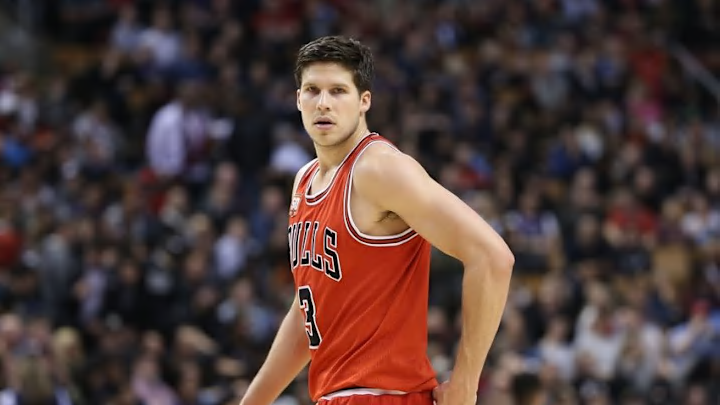By all accounts, last season was a positive one for Doug McDermott. Although the Chicago Bulls struggled at times and ultimately missed the playoffs, the second-year wing finally looked a little like the sharpshooting floor-spacer the Bulls thought they were getting when they traded up to take him with the No. 11 pick in the 2014 NBA Draft.
Like most young players, McDermott still has plenty to work on. Although he may never be the versatile primary scorer he was at Creighton, his bounce back second season leaves one optimistic that he has a future as a perimeter shooting specialist. Players in that role generally need to be able to offer at least some defensive resistance, an area in which McDermott has continued to struggle. It would seem obvious that the only thing standing between him and a long and useful NBA career is the ability to apply something approaching league-average defense.
However, McDermott may still have a few other barriers to surpass.
To compare McDermott to other players who filled a similar role, I identified every player in the three-point era (1979-present) who played at least 1000 minutes with a usage rate below 20 percent, an assist rate below 12 percent, and attempted a third or more of their shots from behind the three point line. Those benchmarks theoretically isolate players who are part of a rotation and whose primary offensive contribution is spotting up outside the arc.
Each player is graphed by their Offensive and Defensive Box Plus-Minus, a box scored based estimate of a player’s net impact per 100 possessions.

You can see that among this cluster of similar players, McDermott is estimated by BPM to be one of the absolute worst defenders. BPM is not a perfect measure of defensive performance but this is a place where the numbers and the eye-test align pretty well.
More from Nylon Calculus
- Nylon Calculus: Reviewing preseason predictions for the Western Conference
- Nylon Calculus: Reviewing preseason predictions for the Eastern Conference
- Nylon Calculus: LeBron James and the slam dunk aging curve
- The Whiteboard: Why has the NBA seen so many 50 point games this season?
- Nylon Calculus: 15 early season predictions for the NBA Western Conference
Obviously, the long-term viability of McDermott as an important player on a good team rests in large part on him improving his defense. However, his overall offensive impact is a problem area as well. Although McDermott shot a robust 42.5 percent on three-pointers last season on a high number of attempts, he didn’t offer much else on the offensive end. He had nearly as many turnovers (53) as assists (59) and shot 55.4 percent inside the restricted area, 152nd of 186 players with at least 150 attempts in that area.
If we look at granular usage statistics, McDermott used just 26 possessions as the ball-handler in the pick-and-roll, just 21 in post-ups and less than 10 as the screener in the pick-and-roll. Almost all of McDermott’s half-court offensive opportunities were spotting up or coming off screens and curls. His jump shot was reliable this season but he had less than 100 drives on the entire season and shot just 39.1 percent on those drives — a reflection of how ineffective he was attacking closeouts or doing something other than shooting off the catch.
Two players that McDermott was often linked to as a draft prospect were J.J. Redick and Kyle Korver. Although there are some significant differences between the three, they were often connected because of the way they carried their college teams’ offenses in ways that were assumed to be unsustainable in the NBA. In addition, all three were perceived to be poor defenders with below average athleticism.
The graph below shows the same info as above but includes the first five seasons of Redick and Korver’s career.

Both Korver and Redick established themselves in the NBA, in part, by improving their defense from where they started. Neither was ever an exceptional defender but they both pushed closer to average than tire fire as they proved themselves as viable assets for a good team. However, both players evolved far more as offensive players over the early part of their careers.
By their fifth seasons, both Redick and Korver had developed into capable passers — Redick by running the pick-and-roll and Korver swinging the ball around the perimeter. Both averaged around twice as many assists per 36 minutes as McDermott did last season. They also got to the free throw line far more often, took more three-pointers (the specialty of all three) than McDermott did and were better finishers around the basket.
More from NC: Projecting the 2016 rookie class forward
With a reworked roster there will be plenty of challenges for Chicago this season. With the pairing of Rajon Rondo and Dwyane Wade in the backcourt, they’ll desperately need McDermott’s shooting on the wing. However, rounding out his offensive game could be far more important for his NBA future, and the success of the team this year, than trying to fix all of his obvious defensive problems.
